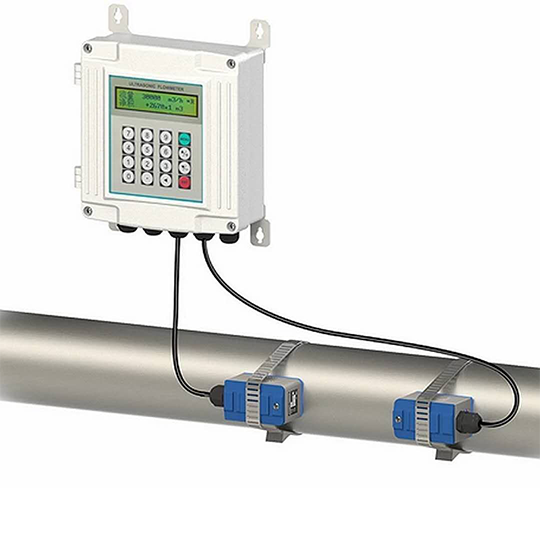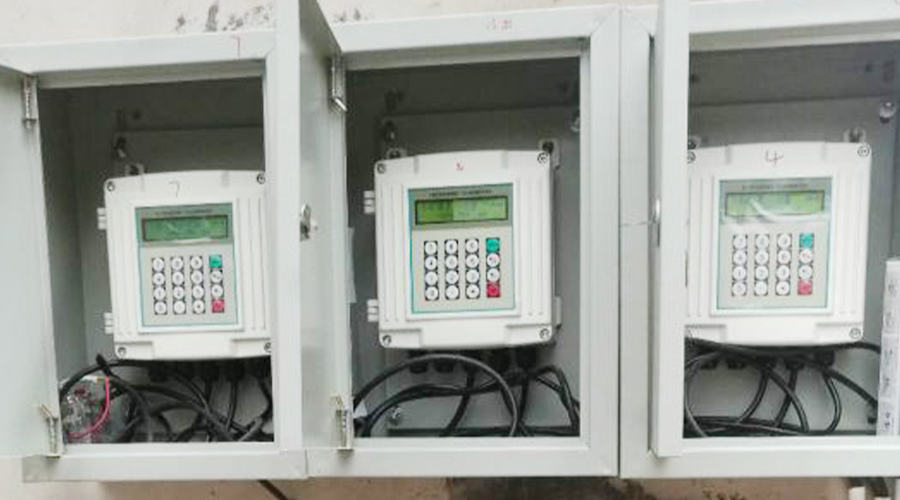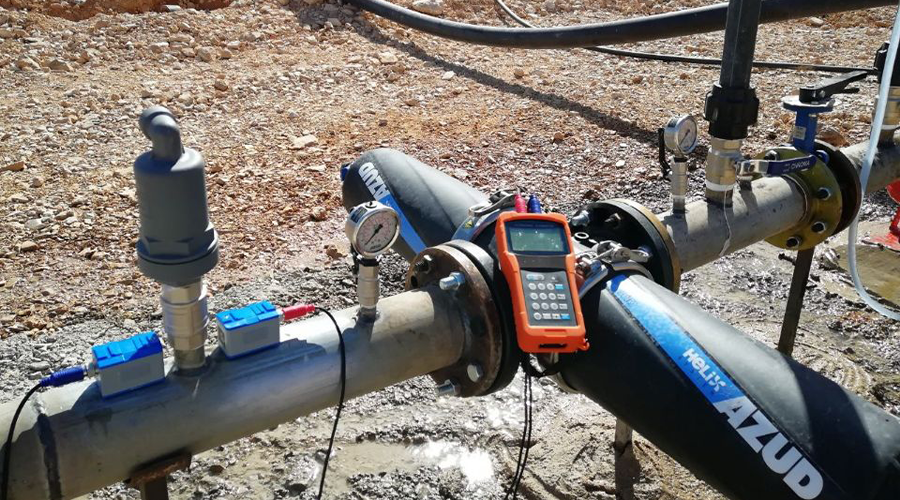What is an Ultrasonic Flow Meter and How Does it Work?
An ultrasonic flow meter is a type of flow meter that uses sound waves to measure the velocity of fluid flow in a pipe. It works by transmitting ultrasonic waves into the fluid flow, and then measuring the time it takes for the waves to travel upstream and downstream in the pipe. The difference in time between the upstream and downstream waves is used to calculate the velocity of the fluid flow, which can then be used to determine the flow rate.
There are two main types of ultrasonic flow meters: transit-time and Doppler. Transit-time meters use two ultrasonic transducers that are placed on opposite sides of the pipe, and they alternate transmitting and receiving signals. When the fluid is flowing, the upstream transducer sends an ultrasonic signal that is received by the downstream transducer. The downstream transducer then sends a signal that is received by the upstream transducer. The difference in the times between the two signals is used to calculate the flow rate.
Doppler meters, on the other hand, use a single transducer that sends an ultrasonic signal into the flowing fluid. When the signal encounters particles or bubbles in the fluid, it is reflected back to the transducer at a slightly different frequency. By measuring the change in frequency, the velocity of the fluid can be calculated.
Ultrasonic flow meters are used in a variety of industries and applications, including water treatment, oil and gas, chemical processing, and HVAC systems. They are known for their accuracy, reliability, and versatility, and are often used in applications where other types of flow meters may be impractical or unreliable.
What is the benefit of ultrasonic flow meter?
There are several benefits to using ultrasonic flow meters, including:
- Non-intrusive measurement: Ultrasonic flow meters do not require any insertion into the pipe or any contact with the fluid, making them non-intrusive and avoiding any potential for contamination or pressure drop.
- Wide range of applications: Ultrasonic flow meters can be used to measure the flow of a wide range of fluids, including water, chemicals, oils, and gases.
- Accurate measurements: Ultrasonic flow meters can provide highly accurate measurements, with accuracy levels of up to 0.5% of reading or better.
- Low maintenance: Ultrasonic flow meters have no moving parts and require minimal maintenance, reducing the need for frequent calibration or replacement.
- Cost-effective: Compared to other types of flow meters, ultrasonic flow meters can be more cost-effective over the long term due to their low maintenance and high accuracy.
Top 5 Applications for Ultrasonic Flow Meters
Ultrasonic flow meters are widely used in a variety of industries and applications due to their non-intrusive nature, high accuracy, and versatility. Here are the top 5 applications for ultrasonic flow meters:
Water and wastewater: Ultrasonic flow meters are commonly used in water treatment facilities to measure the flow of water and wastewater. They can also be used for leak detection and to monitor water usage.
Chemical and petrochemical: Ultrasonic flow meters are used in the chemical and petrochemical industries to measure the flow of liquids, gases, and steam. They can be used for process control, batching, and custody transfer applications.
Oil and gas: Ultrasonic flow meters are used in the oil and gas industry to measure the flow of crude oil, refined products, and natural gas. They can be used for custody transfer, pipeline monitoring, and well testing applications.
HVAC: Ultrasonic flow meters are used in heating, ventilation, and air conditioning (HVAC) systems to measure the flow of water and other fluids. They can be used for energy management and system balancing.
Power generation: Ultrasonic flow meters are used in power generation facilities to measure the flow of water and other fluids in cooling systems, boilers, and other equipment. They can be used for efficiency monitoring and maintenance purposes.
3 Types of Ultrasonic Flow Meters
There are generally three types of ultrasonic flow meters:
Transit-time Ultrasonic Flow Meters
Transit-time ultrasonic flow meters are a type of flow meter that works by measuring the time difference between ultrasonic signals sent upstream and downstream in a pipe.
The basic principle behind transit-time ultrasonic flow meters is that the time it takes for an ultrasonic signal to travel upstream is different from the time it takes to travel downstream, depending on whether or not the flow is moving with or against the direction of the signal. When the flow is moving with the signal, it will speed up the signal, and when the flow is moving against the signal, it will slow it down. By measuring the difference in time it takes for the signal to travel in each direction, the flow rate can be calculated using the following formula:
Flow rate = distance / (time upstream + time downstream)
To measure the transit-time, two ultrasonic transducers are placed on opposite sides of the pipe, one upstream and one downstream. The transducers send ultrasonic signals across the pipe to each other. When the flow is moving with the signal, the time it takes for the signal to travel from the upstream transducer to the downstream transducer is shorter than the time it takes for the signal to travel from the downstream transducer to the upstream transducer. The opposite is true when the flow is moving against the signal. The transit-time flow meter measures these time differences and uses them to calculate the flow rate.
Doppler Ultrasonic Flow Meters
Doppler ultrasonic flow meters operate on the principle of the Doppler shift, which is the change in frequency of sound waves that occurs when the waves bounce off a moving object. The meter sends out ultrasonic waves that bounce off the particles in the fluid being measured, and the frequency shift of the reflected waves is analyzed to determine the velocity of the particles. The velocity information is then used to calculate the flow rate of the fluid.
Doppler ultrasonic flow meters are ideal for measuring flow in fluids that contain suspended particles or bubbles that can reflect the ultrasonic waves. They are commonly used in wastewater treatment plants, mining slurries, and other industrial applications where the fluid being measured is not a pure liquid. Doppler flow meters are also relatively easy to install, and they do not require the pipe to be completely full, making them a versatile and convenient option for many applications. However, they may not be as accurate as other types of flow meters, especially at low flow rates.
Hybrid Ultrasonic Flow Meters
Hybrid ultrasonic flow meters combine the principles of both transit-time and Doppler technologies. They use a pair of ultrasonic transducers to measure both the transit-time and the Doppler shift in the fluid.
In the transit-time mode, the ultrasonic pulses are sent in the upstream and downstream directions, and the time difference between them is used to calculate the flow velocity. In the Doppler mode, the ultrasonic pulses are reflected off particles or bubbles in the fluid, and the frequency shift caused by the motion of these particles is used to determine the flow velocity.
The hybrid ultrasonic flow meter uses both modes simultaneously to compensate for fluid properties and improve accuracy in difficult applications, such as those with high temperature, low viscosity, or low flow rates. The transit-time mode is used to measure the velocity of the fluid, and the Doppler mode is used to determine the presence of particles or bubbles and correct for their effect on the measurement. The hybrid ultrasonic flow meter can also switch between the two modes based on the fluid conditions and adjust the measurement accordingly.
Post time: Mar-17-2023



